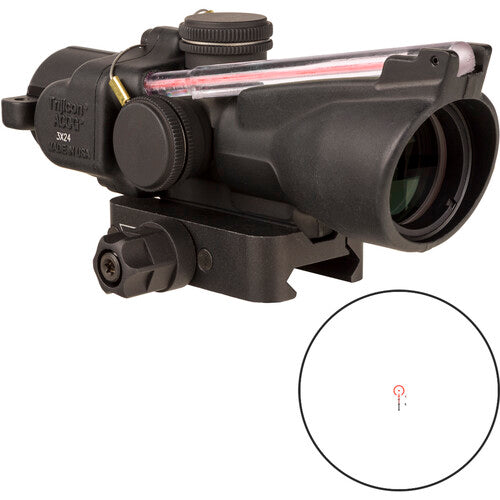

Trijicon ACOG 3x24 Compact Riflescope combines precision optics with a lightweight design, making it ideal for tactical applications. With a fixed 3x magnification and a compact length of just 5 inches, this riflescope is easy to handle and offers effective target acquisition. Weighing only 6.1 ounces, it ensures minimal impact on your rifle's maneuverability. The robust construction from 7075-T6 aircraft-grade aluminum alloy enhances durability while maintaining a manageable weight.
The dual illumination system utilizes fiber optics and tritium, providing a bright red horseshoe dot reticle that remains visible in all lighting conditions. This scope is calibrated for 55-grain .223 cartridges, ensuring quick target acquisition and improved accuracy. A generous eye relief of 1.4 inches and a wide field of view of 25.6 feet at 100 yards allow for rapid target engagement, making it a reliable choice for both tactical shooters and competitive marksmen.
Key Features:
- DUAL ILLUMINATION: Fiber optics and tritium provide a clear reticle in varying light, ensuring visibility without batteries.
- RUGGED CONSTRUCTION: Made from 7075-T6 aircraft-grade aluminum, this scope is both lightweight and exceptionally durable.
- COMPACT SIZE: At 5 inches long and 6.1 ounces, it offers portability without sacrificing optical performance.
- FIXED MAGNIFICATION: 3x magnification balances close-quarter and medium-range shooting capabilities.
- SPECIALIZED RETICLE: Red Horseshoe Dot reticle tailored for .223 cartridges improves speed and accuracy when aiming.
- WIDE FIELD OF VIEW: 25.6 feet at 100 yards enhances situational awareness, allowing for quicker target transitions.
- GENEROUS EYE RELIEF: 1.4 inches of eye relief accommodates various mounting options and reduces recoil impact.
- BINDON AIMING CONCEPT: Enables both-eyes-open shooting, enhancing situational awareness for rapid engagement.
Technical Specifications
| Specification | Detail |
|---|---|
| Model | TA50-C-400354 |
| Magnification | Fixed 3x |
| Objective Lens Diameter | 24mm |
| Length | 5 inches |
| Width | 1.8 inches |
| Height | 2.1 inches |
| Weight | 6.1 ounces |
| Tube Size | Trijicon Q-LOC mount |
| Reticle | Illuminated Horseshoe Dot |
| Reticle Calibration | 55 grain .223 Cartridges |
| Field of View | 25.6 feet @ 100 yards (4.9°) |
| Exit Pupil | 8mm |
| Eye Relief | 1.4 inches |
| Illumination | Dual (Fiber optics and Tritium) |
| Parallax Setting | Fixed |
| Construction Material | 7075-T6 aircraft grade aluminum alloy |
| UPC | 719307314139 |
| MPN | 400354 |
What's in the Box?
- Trijicon ACOG 3x24 Compact Riflescope
- Trijicon Q-LOC mount
- User manual
- Warranty card
Customer Reviews
“The clarity and durability of this scope are unmatched. Perfect for quick target acquisition.”
“Lightweight and compact, this ACOG has transformed my shooting experience. Highly recommend!”
“The dual illumination system works flawlessly in various lighting conditions. A must-have for any serious shooter.”
FAQ
Many buyers wonder about the performance of the Trijicon ACOG 3x24 in different lighting conditions. The dual illumination system effectively utilizes fiber optics during the day and tritium at night, ensuring reliable visibility without batteries. This feature allows for consistent performance across various environments, making it suitable for tactical use.
Another common concern is maintenance. The rugged construction from aircraft-grade aluminum helps the scope withstand harsh conditions, but regular cleaning of the lenses will maintain optimal clarity. A soft cloth and appropriate lens cleaner are recommended for upkeep.
When comparing this scope to other options, the fixed 3x magnification offers specific advantages for medium-range engagements. Shooters who prioritize quick target acquisition may find this model more beneficial than scopes with higher magnification that can slow down aiming. The compact design also enhances maneuverability, particularly in tactical situations.
Similar Models
Looking for more options in tactical optics? Explore our extensive Trijicon lineup, including the Trijicon ACOG 4x32 for a higher magnification and the Trijicon VCOG 1-6x24 for versatile zoom capabilities. Check out our full collection for a variety of optics tailored to meet your shooting needs.
You May Also Like
Here’s some of our most similar products people are buying. Click to discover trending style.












